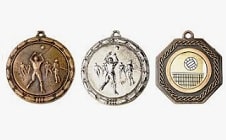 The concept of medal , which comes from the Latin word medaglia , refers to a metallic object , generally round in shape and thin, that presents a symbol , an inscription or a carved or engraved figure. The medals therefore resemble small discs .
The concept of medal , which comes from the Latin word medaglia , refers to a metallic object , generally round in shape and thin, that presents a symbol , an inscription or a carved or engraved figure. The medals therefore resemble small discs .
Similar to coins although larger, medals are usually awarded for recognition or for commemorative purposes . There are also artistic medals and medals of religious cult .
A medal can be made from gold, platinum, bronze, silver, copper, nickel or other materials. The discipline focused on the analysis of the origin and characteristics of medals is called medal science .
Olympic medals are among the best known in the world . These are the medals obtained by athletes who manage to reach the podium in an Olympic Games competition. While the winner receives a gold medal , the second place finisher receives a silver medal . Whoever finishes in third place, meanwhile, wins a bronze medal .
In the United States , the Medal of Honor is the highest decoration awarded by the Armed Forces . This honor is given to he who, in combat against enemies of his country, puts his life at risk beyond what is ordered in the line of duty.
The Saint Benedict medal , on the other hand, features iconography of Benedict of Nursia . It is usually worn by Catholic, Orthodox, Methodist, Lutheran and Anglican believers. This medal is considered one of the oldest in Christianity and is attributed with the ability to protect the wearer against evil .
In 1985, the Junta de Andalucía created the honorary title called Medal of Andalusia , which has the goal of highlighting the merits, services and extraordinary acts carried out in times of peace by certain citizens, entities or groups in the region. , from the country or even from abroad, that focus on solidarity and dedication to others.
 Before the medal is awarded, a file is made in the Office of the President to leave a reliable record of the merits recognized in those who will receive it. Every year, specifically on February 28, up to ten medals are awarded within the framework of Andalusia Day , a date on which several official events are celebrated.
Before the medal is awarded, a file is made in the Office of the President to leave a reliable record of the merits recognized in those who will receive it. Every year, specifically on February 28, up to ten medals are awarded within the framework of Andalusia Day , a date on which several official events are celebrated.
The person who receives the Medal of Andalusia is treated as Most Illustrious Lord or Most Illustrious Lady and is placed in second place within the high ranks granted by the Board, after Favorite Son/Daughter of Andalusia . As is often the case with other awards, the percentage of men and women among the recipients is not equal: throughout the first thirty-three years, for example, only 23% of the medals were awarded to women.
The Chapel of Our Lady of the Miraculous Medal is located in Paris, France, on the site where the Virgin Mary manifested herself on November 27, 1830 and asked Saint Catherine Labouré to create a medal, which was eventually named from Milagrosa .
Saint Catherine described the woman who appeared to her as someone extremely beautiful, who crossed the presbytery with majesty and sat down in a chair at the main altar, next to the Gospel . She said that the sweetness that invaded her during the presence of the Virgin at that moment was unprecedented and that she had never felt so comfortable again in her life. On the obverse of the medal we see the Virgin stepping on the snake that represents Satan, while on the reverse we see the letter "M", the cross and twelve stars.
